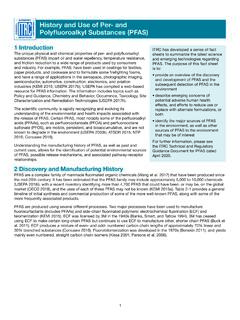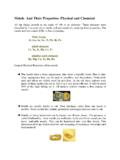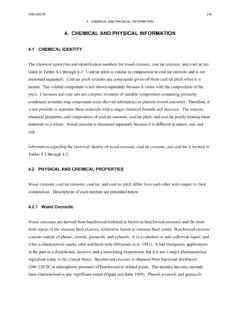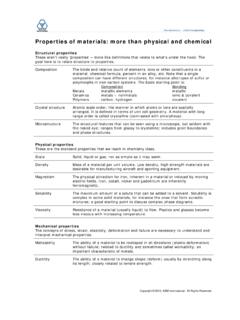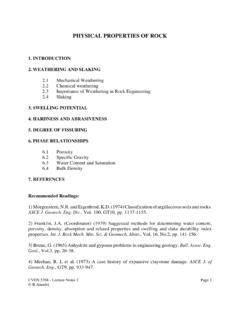Transcription of Naming Conventions and Physical and Chemical Properties …
1 1 Naming Conventions and Physical and Chemical Properties of Per- and Polyfluoroalkyl Substances (PFAS)1 IntroductionThe following topics are covered in this fact sheet: Polymer vs. Nonpolymer PFAS Perfluoroalkyl substances Polyfluoroalkyl substances PFAA Naming Conventions Long-Chain vs. Short-Chain Linear vs. Branched Acid vs. Anion Replacement Chemistry Physical and Chemical PropertiesThis fact sheet uses three Conventions worth highlighting: Anionic form of Chemical names: Many PFAS can exist in various ionic states (for example, acids, anions, cations), which has important implications for their Chemical and Physical Properties . In most cases, this fact sheet uses the anionic form of a given PFAS name, as this is the state in which most PFAS exist in the environment.
2 PFC is not used: The acronym PFC is poorly defined in the scientific literature, but typically refers to perfluorinated compounds. It does not include polyfluorinated substances which are increasingly recognized as important contaminants at many PFAS sites, while it does include unrelated chemicals that are not of concern at those sites. PFAS , not PFASs : The acronym PFAS stands for per- and polyfluoroalkyl substances. No single Chemical within the PFAS class can be both polyfluorinated and perfluorinated, so by definition PFAS is plural and a small s is not needed. Some authors elect to add a small s to this acronym (PFASs) to emphasize the fact that it is plural, but it is not needed. When referring to a single Chemical within the PFAS class, it is usually more accurate to simply name that specific Chemical .
3 USEPA has compiled an online resource for PFAS information. The information includes topics such as Policy and Guidance, Chemistry and Behavior, Occurrence, Toxicology, Site Characterization and Remediation Technologies (USEPA 2017h). Why do we need to understand PFAS Naming Conventions ?The number and complexity of environmentally-relevant PFAS and the exponential increase in related scientific publications have led to confusion in the environmental community and the public (Buck et al. 2011; Wang et al. 2017). The use of non-specific acronyms, such as perfluorinated compound (PFC), has hampered clarity of investigative results. Use of consistent Naming Conventions by researchers, practitioners, regulators, and stakeholders will reduce confusion and support clearer communication.
4 Proper Naming also helps to distinguish PFAS from other organic compounds that contain fluorine. PFAS, which are fluorinated aliphatic (carbon chain) substances, do not include aromatic (carbon ring) substances that contain carbon-fluorine (C-F) bonds (for example, active pharmaceutical ingredients, crop protection) or chlorofluorocarbons (refrigerants). This is another reason to avoid the use of the more generic acronym, PFC, which can include these Abstract Service (CAS) numbers are another helpful tool for clearly identifying the Chemical that is being referenced. However, even these have led to confusion when it comes to PFAS. Some PFAS may occur in various ionic states, such as acids, anions (negatively charged), cations (positively charged salts), and zwitterions (both positively and negatively charged dipolar molecules), each of which has its own CAS number (and some have no CAS number).
5 The ionic state determines its electrical charge and its Physical and Chemical Properties , which in turn controls its fate and ITRC has developed a series of six fact sheets to summarize the latest science and emerging technologies regarding PFAS. The purpose of this fact sheet is to: Provide an overview of terminology, names, and acronyms for PFAS, focusing on those most commonly reported in the environment. The fact sheet focuses on those PFAS most commonly tested for by current analytical methods, but also describes other important classes of PFAS. Summarize the common Physical and Chemical Properties associated with PFAS, along with a discussion of those Properties for which no data are currently available.
6 For further information, please see the ITRC Technical and Regulatory Guidance document for PFAS dated April Conventions and Physical and Chemical Properties of Per- and Poly uoroalkyl Substances (PFAS) continuedtransport in the environment and potential human health and ecological effects. Chemical and Physical Properties of the various states of a given per- or polyfluoroalkyl substance can be so different that they completely alter critical aspects of the substance, such as solubility, volatility, and bioaccumulative potential. As a result, care must be taken in selecting the correct CAS number to avoid confusion regarding the chemistry and behavior of the Chemical being described. 2 PFAS FamiliesPFAS encompass a wide universe of substances with very different Physical and Chemical Properties , including gases (for example, perfluorobutane), liquids (for example, fluorotelomer alcohols), surfactants (for example, perfluorooctane sulfonate), and solid material high-molecular weight polymers (for example, polytetrafluoroethylene [PTFE]).
7 For this reason, it is helpful to arrange PFAS that share similar Chemical and Physical Properties into PFAS families may be divided into two primary categories: polymer and nonpolymer as shown in Figure 2-1. This fact sheet focuses primarily on nonpolymer PFAS most commonly detected in the environment. The polymer family of PFAS is not addressed in detail in this fact sheet. Buck et al. (2011) is an open-access paper that provides a more detailed explanation of PFAS terminology, classification, and origins, and recommends specific and descriptive terminology, names, and acronyms for 2-1. Summary of PFAS Nonpolymer PFASThe family of nonpolymeric PFAS encompasses two major classes: perfluoroalkyl substances and polyfluoroalkyl substances, which include many subgroups of chemicals, examples of which are shown in Figure 2-1.
8 Table 2-1 provides general classification and Chemical structures, examples of each class, and primary uses of the nonpolymer PFAS highlighted in Figure 2-1. These compounds were selected as the focus of this fact sheet because they (1) are most commonly detected in humans, biota, and other environmental media; (2) appear to be relatively more abundant at PFAS investigation sites; (3) may have state or federal guidance values (see the Regulations, Guidance, and Advisories Fact Sheet); and/or (4) are included in most laboratory PFAS analyte lists. Perfluoroalkyl SubstancesPerfluoroalkyl substances are fully fluorinated (perfluoro-) alkane (carbon-chain) molecules. Their basic Chemical structure is a chain (or tail) of two or more carbon atoms with a charged functional group head attached at one end.
9 The functional groups commonly are carboxylates or sulfonates, but other forms are also detected in the environment. Fluorine atoms are attached to all possible bonding sites along the carbon chain of the tail, except for one bonding site on the last carbon where the functional group head is attached. This structure, which is illustrated in Figure 2-2 for perfluorooctane sulfonate (PFOS) and perfluorooctanoate (PFOA), can be written as:CnF2n+1-RPerfluoroalkyl SubstancesPerfluoroalkane sulfonamides (FASAs)Perfluoroalkyl acids (PFAAs)Perfluoroalkyl carboxylic acids/ Perfluoroalkyl carboxylates (PFCAs)Perfluoroalkane sulfonic acids/Perfluoroalkane sulfonates (PFSAs)Fluorotelomer-based substancesPolyfluoroalkyl ether carboxylic acids Perfluoroalkanesulfonamido substancesPolyfluoroalkyl SubstancesPolymersFluoropolymersPerfluor opolyethers (PFPE)Side-chain fluorinated polymersPFASN onpolymers3 Naming Conventions and Physical and Chemical Properties of Per- and Poly uoroalkyl Substances (PFAS) continuedwhere CnF2n+1 defines the length of the perfluoroalkyl chain tail, n is >2, and R represents the attached functional group head.
10 Note that the functional group may contain 1 or more carbon atoms, which are included in the total number of carbons when Naming the 2-2. The tail and head structure of PFOS and PFOA moleculesTable 2-1. Major PFAS classes discussed in this fact sheetPerfluorooctane carboxylate (PFOA)F3C-CF2-CF2-CF2-CF2-CF2-CF2 TailCO2-HeadPerfluorooctane sulfonate (PFOS)F3C-CF2-CF2-CF2-CF2-CF2-CF2-CF2 TailSO3-HeadFigure 2-5 EditedFamily Class Group General Chemical Structure: CnF2n+1R, where R = Examples Uses PERFLUORINATED Perfluoroalkyl acids (PFAAs) Perfluoroalkyl carboxylic acids (PFCAs) -COOH Perfluorooctanoic acid (PFOA), C7F15 COOH Surfactant Perfluoroalkyl carboxylates (PFCAs) -COO- Perfluorooctanoate (PFOA), C7F15 COO- Perfluoroalkane sulfonic acids (PFSAs) -SO3H Perfluorooctane sulfonic acid (PFOS), C8F17SO3H Surfactant Perfluoroalkane sulfonates (PFSAs) -SO3- Perfluorooctane sulfonate (PFOS), C8F17SO3- Perfluoroalkane sulfonamides (FASAs) Perfluoroalkane sulfonamides (FASAs) -SO2NH2 Perfluorooctane sulfonamide (FOSA), C8F17SO2NH2 Major raw material for surfactant and surface protection products Source: Adapted with permission from Buck, , J.
